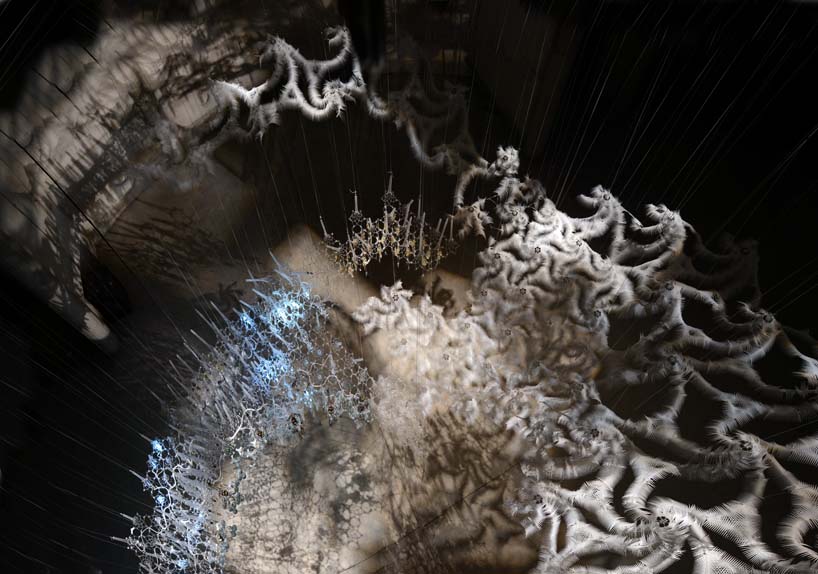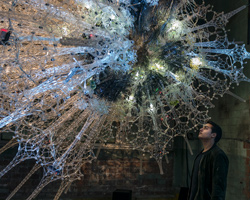philip beesley & co.’s interactive canopy installation in shanghai whispers choruses
all images courtesy of philip beesley
for the shanghai urban space art season design exhibition, artist, architect and waterloo architecture professor, philip beesley has teamed up with the living architecture systems group, composed of architects, scientist and artists working with collaborators from the USA and europe, to create the ‘spring dragon tail’, a sentient canopy installation that floats within a glass-enclosed central theatre. the artwork creates an environment that is composed of a series of expanded mesh stainless steel and thermally formed acrylic components that combine to make a resilient structural waffle. interlocking spiral clouds of acrylic and mylar provide outer filters expanding a densely massed inner chamber. the hexagonal cellular structural system of this chamber is interwoven with distributed sound and light networks.

an aerial view shows interconnected spiral geometry filters
a necklace of sounding cells is triggered by two overlapping sources, including organic vinegar liquid batteries and proximity detectors tracking the gestures and position of the occupants. dense masses of traube protocells are bedded in layered oils that provide balanced protective housings, supporting the formation of delicate chemical veils within the glass manifold. chains of high-power LEDs are fitted to the protocell vessels, providing stimulation for growth. the interactive systems feature the first generation of proprioreceptive sensors, enabling internal feedback within the control systems. this distributed system forms a testbed that can lead to machine learning.

the immersive environment includes fields of interactive distributed sound, light and liquid chemistry
the sentient canopy, equipped with sensors, reacts with people’s presence and starts playing synthesis-based sounds of the murmuring ocean. once immersed in the installation, a feeling of science, laboratory, molecularity and technology arise, involving the occupants by making them interact with the piece.

interlinked glass vessels enclose liquid protocells that are stimulated by light bursts from LED’s

this general view shows the structure of the inner densely massed chamber flanked by aerial filter canopies

cloud-like mylar filters add a molecular feeling to the whole installation

the inner chamber of the canopy has densely massed custom glass vessels, fitted with high-powered LED’s

the glass vessels are controlled by sensors that are arrayed in the hexagonal structure

individual clusters of LED’s are stimulated by proximity detectors, chained together to make larger rolling clouds

bursts of high-powered LED light stimulate the growth of protocells housed within the glass manifold

this aerial view shows chained busts of LED light within suspended mylar and acrylic cloud canopy

detail view of the mylar filter with light-gathering custom glass vessels
designboom has received this project from our ‘DIY submissions‘ feature, where we welcome our readers to submit their own work for publication. see more project submissions from our readers here.
edited by: juliana neira | designboom












